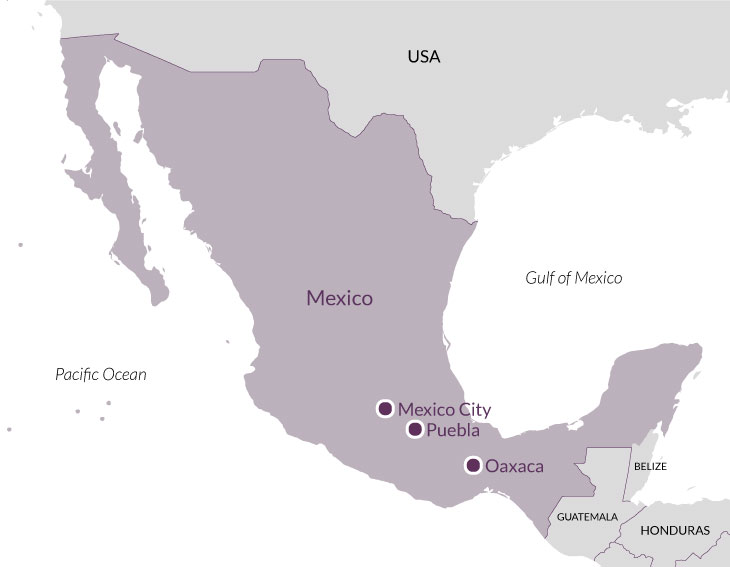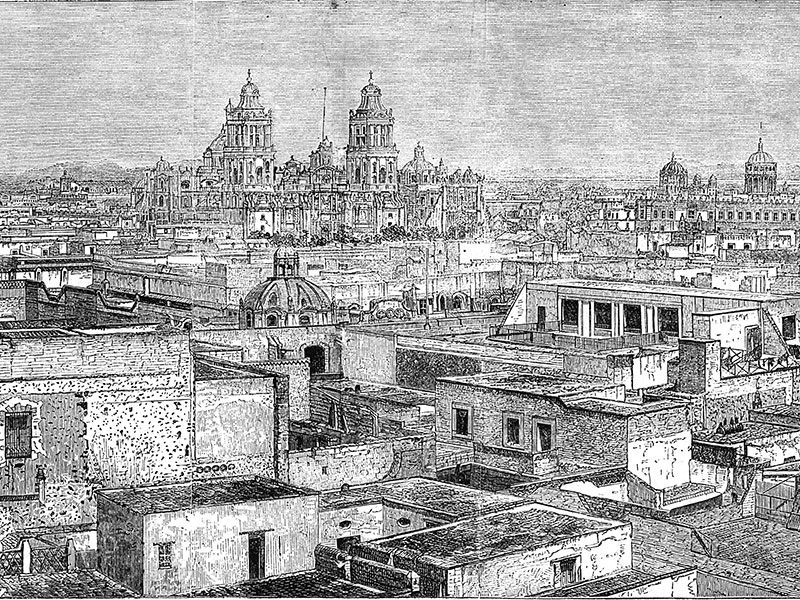Overview
Central Mexico is one of the most naturally and culturally varied parts of the New World: broad upland basins lie between rugged cordilleras, with vegetation ranging from subtropical forest to semi-desert, and on the descent to the Pacific and Gulf Coasts, tropical rainforest. Early Mexican cultures began with hunters and gatherers, then the development of farming villages based on maize, beans and root crops led to the emergence of the Olmec, with their stunning sculptures including colossal heads depicting deceased rulers. All are represented in the stunning National Museum of Anthropology, together with the Maya and Zapotec civilisations and their modern descendants.
Related groups in the Basin of Mexico left monuments such as the Cuicuilco pyramid, now buried under volcanic lava, and were superseded by the metropolis of Teotihuacan, dominated by the Sun and Moon Pyramids and the Temple of Quetzalcoatl, a grid-planned city whose population may have reached 100,000 in the early centuries ad. Cholula was a powerful contemporary, still largely buried beneath the colonial city, while at the same time, across the mountains in Oaxaca, the great Zapotec hilltop centre of Monte Alban rose above a long-inhabited valley. Its people had diplomatic and trade relations with both Teotihuacan and eastward, where the Classic Maya shared the same cultural foundations. Maya contacts with the highlands are seen in the colourful murals of Cacaxtla and in imported ceramics, while striking parallels between Chichén Itzá and distant Tula, north of the Valley of Mexico suggest possible migrations or invasion.
Certainly the Aztecs were planning a move into Maya territory from their capital at Tenochtitlan, parts of which are emerging below modern Mexico City. They had conquered large parts of the Central Mexican highlands and coastlines over little more than a century, extracting tribute from as far as the borders of Guatemala in jade, chocolate, jaguar pelts and quetzal feathers. Massive sculptures like the Sun Stone, found in the eighteenth century, have been joined by the remains of the Great Temple and other buildings as testimony of Aztec creativity. What Hernán Cortés and his band of Spanish adventurers conquered was a civilisation on the brink of yet further expansion: they absorbed Mexican ideas and images as well as blending with the native people in the emergence of mestizaje, the unique historic-period culture in which Old and New worlds melded. The Catholic faith had resonances in indigenous religions, and its saints often took on aspects of pre-Hispanic deities.
Although Central Mexico is amazingly varied in its peoples, there is a common cultural bedrock that survives the Conquistadors: the Huastec on the Gulf Coast are visibly close to the Mixtec of Oaxaca and the Tlaxcalans who allied themselves with Cortés to defeat the empire of Moctezuma II.

Martin Randall Travel is a member of the Latin American Travel Association – the authoritative voice in the UK for Latin American Travel and Tourism.
Day 1
Fly from London Heathrow to Mexico City via Amsterdam at c. 10.00am (KLM). Arrive at c. 7.30pm and transfer to the hotel in Polanco district. Those not taking our flights can check in from 3.00pm today.
Day 2
Mexico City. After a morning lecture, drive to the centre of the city where the magnificent colonial cathedral stands proud over the vast square of the Zócalo, close to the excavated pyramids of the Templo Mayor, centre of the Aztec city of Tenochtitlán. Its fascinating museum contains finds from the site such as the Tlaltecuhtli (Earth God) monolith. The Palacio Nacional on the Zócalo houses vibrant murals by Diego Rivera depicting the history of Mexico.
Day 3
Mexico City. The National Museum of Anthropology contains some of the finest pre-Columbian artefacts in the world including the famed Aztec calendar stone and Coatlicue statue, as well as important finds from the Maya Area, Oaxaca, and Gulf Coast. Continue in the afternoon to the three-tiered circular structure at Cuicuilco whose people may have fled to Teotihuacan when nearby Xitle volcano erupted.
Day 4
Teotihuacán. Excursion to the country’s largest pre-Hispanic site, dominated by the huge Pyramids of the Sun and the Moon and the Ciudadela complex with its Feathered Serpent Pyramid. Other highlights include well-preserved murals and sculptures of jaguars wearing feathered-headdresses in palace courtyards.
Day 5
Mexico City. The pyramid of Tenayuca in the north of the city is adorned with rattlesnake sculptures, and is the earliest example of the Aztec-style double pyramid. Nearby Santa Cecilia Atitlán is a heavily restored but perfect example of a temple dedicated to the sun and the rain. It was thought that both were be constructed by the Chichimecs before the invasion of the Aztecs, who used copied their architectural style. Free afternoon to explore the craft market, National Museum of History in Chapultepec Castle, or one of the contemporary art museums in Chapultepec park.
Day 6
Tula, Tepozotlán. Drive north of the city to the Toltec site of Tula, where giant warrior figures stand atop the main pyramid, overlooking the “Burnt Palace” and the ball-courts. Continue to Tepozotlán, where the Museum of the Viceroyalty of New Spain depicts the spiritual conquest of Mexico. Housed in a Jesuit monastery, the church has a fine Churrigueresque façade and a sparkling baroque interior.
Day 7
Cacaxtla, Cholula, Puebla. The site of Cacaxtla was inhabited by the Olmeca-Xicalanca people, c. 650–900 ad. The colourful murals they left behind, including a striking battle scene, are remarkably well preserved and display clear Maya influence. The pyramid at Cholula has the greatest volume of any in the New World. Now largely covered by vegetation, its early phases are visited by tunnels. Continue to the lovely colonial city of Puebla for the first of two nights.
Day 8
Xalapa. The spectacular Museum of Anthropology in Xalapa specialises in the findings from pre-Hispanic sites on the Gulf of Mexico, modern day Veracruz, especially the Olmecs, Totonacs and Huastecs.
Day 9
Puebla, Oaxaca. Morning walk around Puebla, including the cathedral, consecrated in 1649 and funded by Spaniard Don José de Palafox from Zaragoza. The Casa de la Cultura is a delightful tiled building housing a library of c. 41,000 books that Palafox donated to the city. The Museo Amparo has a fine collection of pre-Hispanic art. Drive to Oaxaca (c. 4.5 hours) for the first of three nights.
Day 10
Monte Alban, Zaachila, Cuilapam. The vast ceremonial centre of Monte Alban was inhabited by the Zapotecs c. 500 bc–950 ad. See here the famous early Los Danzantes carvings of sacrificial victims and the “observatory” adorned with carvings commemorating Zapotec conquests. Climb down into the Mixtec tombs at Zaachila, with decorated carved walls. The Dominicans built their Convento de Santiago at Cuilapan on a former Mixtec site and remained there to evangelise the indigenous people.
Day 11
Mitla, Oaxaca. The temples of the Mixtec site at Mitla are decorated with intricate, geometric bas-reliefs. Afternoon visits in Oaxaca include the Museo de las Culturas, which houses the Mixtec treasures from Tomb 7 at Monte Alban in a former Dominican convent. The adjacent church of Santo Domingo de Guzmán is a masterpiece of Mexican Baroque.
Day 12
Oaxaca. Free morning to enjoy Oaxaca’s picturesque and colourful streets, excellent craft shopping, baroque churches or Rufino Tamayo’s collection of pre-Hispanic artefacts. Fly at c. 4.00pm to Mexico City (Aeromexico), connecting to a 9.00pm flight to London (British Airways).
Day 13
Arrive at London Heathrow at c. 1.00pm.
Price – per person
Two sharing: £5,970 or £5,160 without international flights. Single occupancy: £6,880 or £6,070 without international flights.
Included: air travel (economy class) from London to Mexico City (via Amsterdam) with KLM (aircraft: Boeing 737-800); domestic flight from Oaxaca to Mexico City with Aeromexico (aircraft: Embraer E-190); transport by private coach; accommodation as described below; breakfasts, 7 dinners (1 is light) and 7 lunches; beer, water, soft drinks and coffee at lunch plus wine at dinner and where available; all admissions to sites and museums; all tips for restaurant staff, drivers, guides; all airport and state taxes; the services of the lecturer, tour manager and local guides.
*This dates for this tour have changed from 4–16 November to 14–26 November.
Accommodation
Las Alcobas, Mexico City: a 5-star boutique hotel in the upscale Polanco district. Hotel Quinta Real, Puebla: a 5-star hotel in a former 16th-cent. convent. Hotel Quinta Real, Oaxaca: also a 5-star hotel in a former 16th-cent. convent. Single rooms are doubles for sole use.
How strenuous?
A fairly taxing tour with some long drives and early starts. Many of the archaeological sites are vast, on rough ground and have steps or hills to negotiate. The tour should not be undertaken by anyone who has the slightest problem with everyday walking and stair-climbing, or who is not sure-footed. Average distance by coach per day: 73 miles.
Are you fit enough to join the tour?
Group size
Between 10 and 22 participants.
Travel advice
Before booking, please refer to the FCDO website to ensure you are happy with the travel advice for the destination(s) you are visiting.

